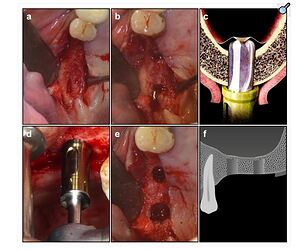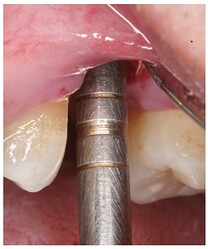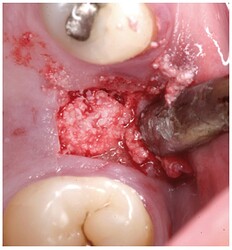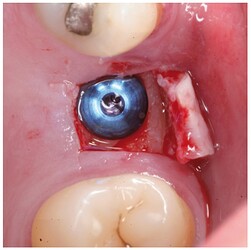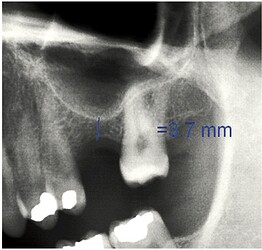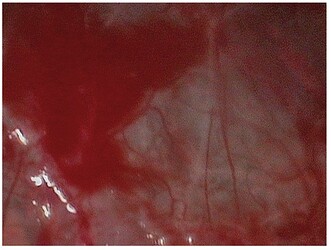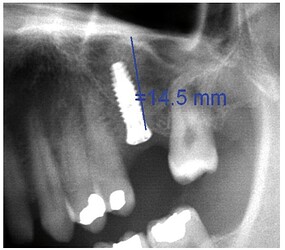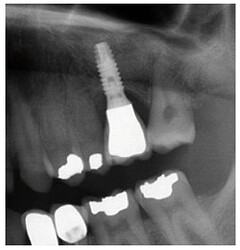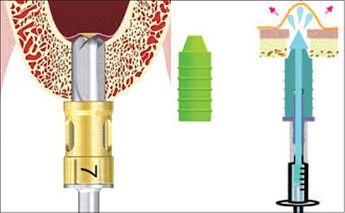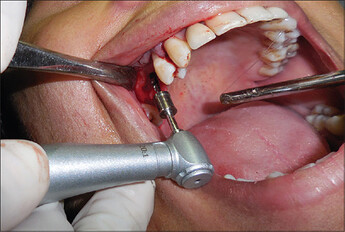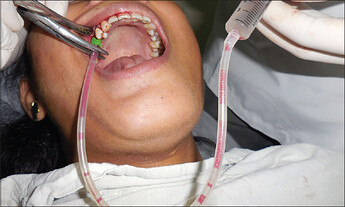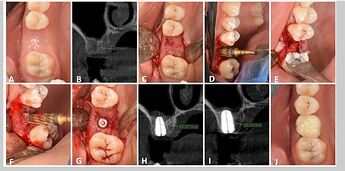This past week, we got a question from a customer about the balloon sinus lift technique vs hydraulic sinus lifting. So we thought, a good topic of the week could be a quick review of various sinus lifting methods. In this issue of This Week in Implants TM, we will review the popular sinus lift techniques, all of which aim in some way to reduce the risk of the procedure, including the the risk of schneiderian membrane perforation. 1,2 Specifically, we cover the following techniques: osteotome sinus floor elevation, balloon assisted elevation, hydraulic sinus lift and finally the use of Densah burs. Note that we do not cover the lateral (direct) approach technique in this post, and instead focus on crestal techniques, as the lateral approach is generally considered more invasive (See: Alternative to Lateral Sinus Lift ) Please feel free to leave your comments below on your preferred technique and why you have chosen it over the others.
Case Photos
Osteotome sinus floor elevation
Source: Kang N, Liu C. Modified Osteotome Sinus Floor Elevation Technique for Multiple Edentulous Spaces: A Non-Randomized Controlled Trial. Int J Environ Res Public Health. 2022 Jun 30;19(13):8019.
Image 1: Sinus floor preparation. (**a** ) performing H incision on teeth 16 and 17. (**b** ) drill preparation. (**c** ) Crestal Approach Sinus Kit (CAS) drill simulation. (**d** ) using CAS drill for preparation. (**e** ) integrated membrane after CAS drill preparation. (**f** ) schematic diagram after drill preparation.Image 2: Schneiderian membrane elevation. (a ) using osteotome to elevate the sinus membrane (>1 mm). (b ) using dome-shaped sinus curette to lift the membrane. (c ) using variously shaped detachers in Dentium Advanced Sinus Kit (DASK) to detach the membrane. (d ) using detachers to elevate the membrane between 2 implants. (e ) using osteotome to ascertain the height of elevation. (f ) integrated membrane after elevation.
Sinus Balloon Technique
Source: Peñarrocha-Diago M, Galán-Gil S, Carrillo-García C, Peñarrocha-Diago D, Peñarrocha-Diago M. Transcrestal sinus lift and implant placement using the sinus balloon technique. Med Oral Patol Oral Cir Bucal. 2012 Jan 1;17(1):e122-8.
Full thickness flap elevation and preparation of the implant bed with drills and osteotomes
Controlled fracture of the floor of the maxillary sinus using an osteotome.
Insertion of the sinus balloon for detachment of the sinus membrane.
Particulate bone graft placement.
Implant positioned in the same surgical step.
Preoperative panoramic X-ray view.
Sinus membrane integrity as established by endoscopy.
Postoperative panoramic X-ray view.
Panoramic X-ray view one year after prosthetic loading.
Hydraulic sinus lift
![]() Note: The new Sinus Lift Kit eliminates the need for a separate device to apply hydraulic pressure and instead uses internal irrigation in specialized crestal reamers.
Note: The new Sinus Lift Kit eliminates the need for a separate device to apply hydraulic pressure and instead uses internal irrigation in specialized crestal reamers.
Source: Manekar VS. Graftless crestal hydraulic sinus lift with simultaneous implant insertion. Natl J Maxillofac Surg. 2020 Jul-Dec;11(2):213-218.
This is a schematic diagram as given by the Hiossen for Crestal Sinus Lift Kit. The left side picture is the safe drill perforating the sinus. The right side shows the waterjet as hydraulic pressure which can lift the sinus membrane
Osteotomy preparation using the drill with stopper attached
The hydraulic system is seen in action attached to the osteotomy, the tubing, and the syringe
Use of Densah burs
Source: Shalash M, Mounir M, Elbanna T. Evaluation of crestal sinus floor elevation in cases exhibiting an oblique sinus floor with a residual bone height of 4.0-7.0 mm using Densah burs with simultaneous implant placement: a prospective clinical study. Int J Implant Dent. 2023 Nov 2;9(1):41…
**a** –**c** Showing sloping sinus floor and sequence of drilling using the Densah bursShowing Densah bur design
a Measuring the amount of bone gain achieved following the Densah lift. b Graft containment around the implant apex. c Angle measurement confirming a sloping sinus floor
Densah Burs Clinical Views
Source: Alajami MM, Elsheikh HA, Abo El-Farag SA, Mansour NA. Antral membrane balloon technique versus Densah bur in crestal sinus lift with simultaneous implant placement: a randomized clinical trial. BMC Oral Health. 2024 Aug 8;24(1):916.
Densah Bur Group. A : Preoperative clinical view, B : preoperative CBCT, C : Full thickness mucoperiosteal flap, D : Densah sinus floor elevation, E & F : Allograft application, G : Implants after placement, H : Immediate postoperative CBCT showing vertical bone height, I : CBCT after 6 months, J : occlusal view of final zirconia crown
Discussion
Reviewing the Techniques
The Osteotome sinus lift approach is the oldest of the techniques mentioned here, with the first iteration described by Summers in 1994. It has since been improved upon in various ways, but the basic technique remains the same. The procedure appears predictable with favourable long-term results. 3 However, when compared to the other techniques, some studies do show a higher rate of sinus membrane perforation with the classic technique. In addition, there is some post-operative pain and discomfort associated with this technique. 4
The balloon elevation technique was introduced by Soltan and Smiler in 2005. The membrane is gently separated by applying consistent pressure while inflating a latex balloon. This technique is regarded as relatively safe, with minimal risk of postoperative bleeding, pain, or discomfort.5. However, it does appear that the technique is somewhat case sensitive in that the osteotomy should be enlarged to 5 mm before inserting the balloon and this might limit the indications for this technique.
The hydraulic sinus technique was introduced 2005 by various clinicians.6,7It is a method that uses eual water pressure to elevate the sinus membrane and prepare the site for implant placement. Clinical outcomes showed a significant increase in subantral bone height from with no membrane perforations or significant complications observed, demonstrating the predictability and safety of the technique. Initially, the hydraulic technique was mostly done with the use of water lift device, but in the last few years major improvements have been made to the technique and now the hydraulic pressure is delivered via internal irrigation in the crestal reamers, greatly simplifying the technique (see Sinus Lift Kit).
The use of densah burs is the newest approach for sinus lifts. The technique is based on the concept of osseodensification, which used these special drills that are designed to densify and compact the bone while minimizing heat generation. Using densah burs for sinus lifts has proven quite effective, with one study reporting that following the procedure: “A significant vertical increase of 7 mm (SD: 2.49) was observed. No sinus membrane perforations and no late implant failures were observed from 6 up to 64 months follow-up, yielding a cumulative implant survival rate of 97%.”8
Which Approach is Best?
The major question of course, is which technique is best? Unfortunately, there is no clear cut answer when it comes to that question, as there are no studies that compare all the techniques.
As it relates to sinus membrane perforation, some studies have shown that both the balloon and hydraulic sinus techniques are preferred over the classic osteotome technique, for reducing the risk of perforation with no clear advantage of the balloon vs hydraulic for elevation. 9
However, when it comes to the osteotome technique one of the main issues is patient discomfort related to the constant tapping of the osteotomes. So any technique that reduces and or eliminates the the need for osteotomes would seem to be preferred. In fact, the use of speclialized crestal reamers, instead of osteotomes has proven quite reliable. As noted in two separate studies, “This reamer-mediated procedure is less invasive than traditional osteotomy and can minimize patient discomfort during sinus floor elevation…” and “The results presented herein indicate that comparable survival rates were achieved for implants placed in conjunction with a reamer- vs osteotome-mediated technique. Therefore, RSFE is a reliable and predictable procedure for implant placement in the posterior maxilla, with a low incidence of complications”10,11
As regards to the balloon technique vs osseodensification, one study concluded that: “Both techniques demonstrated successful clinical and radiographic outcomes for crestal sinus lift. The antral membrane balloon group demonstrated better immediate postoperative vertical bone gain, while Densah burs had higher implant primary stability and bone density.”12
The problem with the balloon technique, though, is that it requires a separate device, so even if you eliminate the use of osteotomes by using crestal reamers (note, however, that most demonstrations of the balloon technique still use osteotomes), you would still need to set up the balloon. Therefore, it appears to us that any technique that simply uses existing drills to simplify the procedure would be preferable clinically. In that regard, Densah Burs (osseodensification) or Crestal Reamers with Internal Irrigation (as used in the Sinus Lift Kit) clearly seem to win out from a clinical perspective.
What has been your experience?
